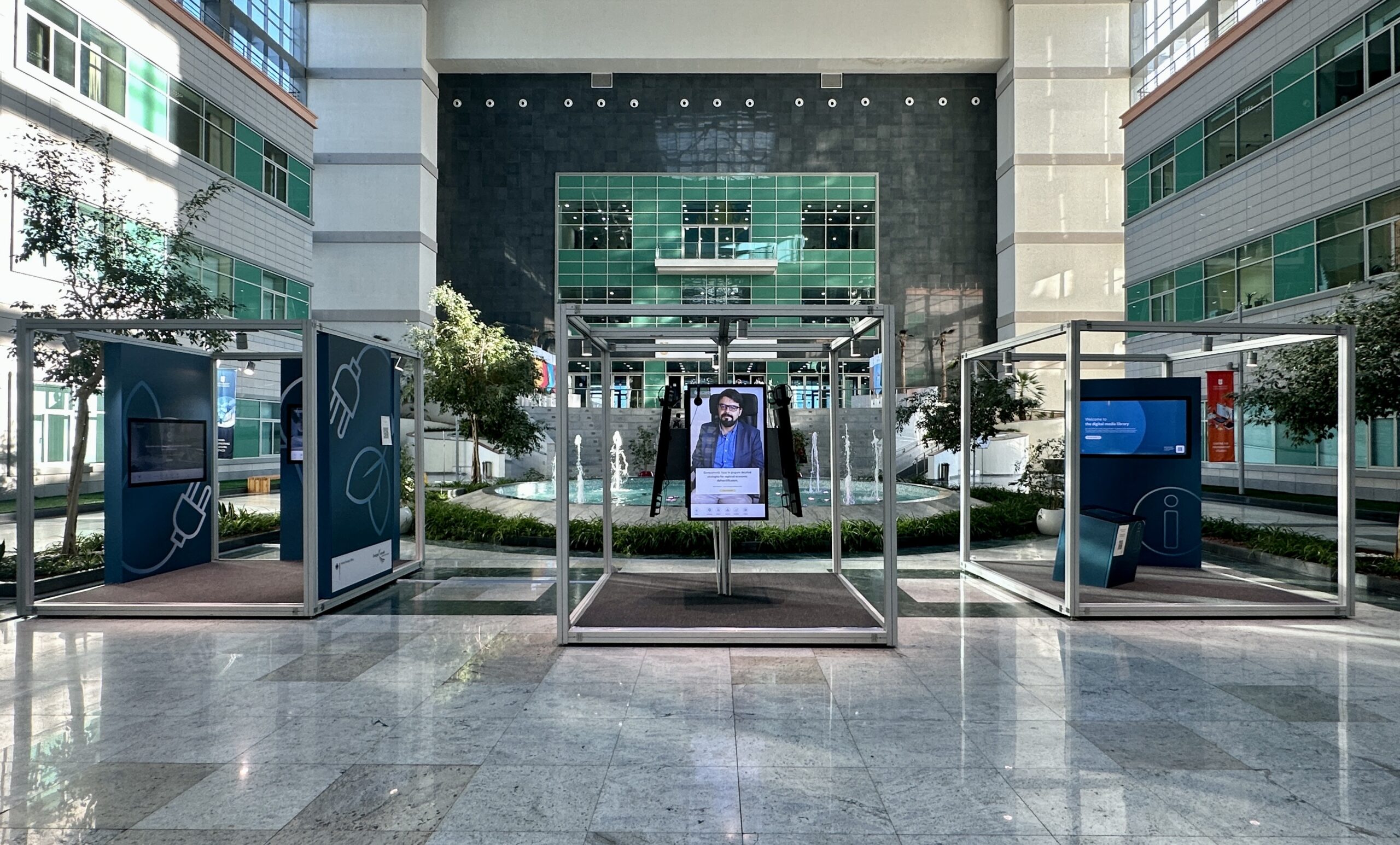ASTANA – The “Energy in Transition – Powering Tomorrow” traveling exhibition opened on Nov. 25 at Nazarbayev University in Astana – its final stop in Central Asia after visiting Aktau and Tajikistan, the Kyrgyz Republic, Turkmenistan, and Uzbekistan. It aims to inspire discussions on energy transitions for a sustainable future.

The “Energy in Transition – Powering Tomorrow” traveling exhibition opened at Nazarbayev University in Astana. Photo credit: Aibarshyn Akhmetkali/The Astana Times
Initiated by the German Federal Foreign Office, the exhibition has traveled globally, including stops in China, the Czech Republic, Egypt, Ireland, Russia, the United Arab Emirates, and Vietnam. In cooperation with the European Union, the German government supports Kazakhstan’s green transition through several projects implemented by Deutsche Gesellschaft für Internationale Zusammenarbeit (GIZ).
“At the ‘Energy in Transition – Powering Tomorrow’ traveling exhibition, we highlight the various perspectives held on the transformation of energy assistance. We want to make a contribution at the local level to the global dialog and discussion on energy transition and just energy transition. Together with our European neighbors and international partners, Astana is one of seven locations where this exhibition has been shown over the years,” said Monika Iwersen, German Ambassador to Kazakhstan, at the opening event.

The event also featured three sessions dedicated to various aspects of energy transition. Photo credit: Aida Dosbergenova/The Astana Times
The exhibition, which will be run through Dec. 12, invites visitors to explore the dynamic landscape of the global energy transition. The experience revolves around five interactive cubes, each addressing a crucial aspect of the global dialogue on energy transition, such as energy transition, renewable energy, mobility, just transition, and info lounge with local content on the energy transition.
What makes this exhibition unique is its depiction of diverse perspectives from a global view, allowing one to choose from politics, science, society, and the economy as lenses to explore the topics.
Kazakhstan’s study on hydrogen
The event also featured three sessions dedicated to various aspects of energy transition. These sessions covered developments related to green hydrogen in Kazakhstan, energy efficiency in public buildings, and an in-depth look at research on renewable energy in Central Asia.
As part of the sessions, Ainur Sospanova, chairwoman of the Qazaq Green Association, presented a study case on hydrogen in Kazakhstan.
“The objective was to analyze the geo-economic challenges Kazakhstan faces in exporting hydrogen and hydrogen derivatives, focusing on environmental sustainability. The first issue we’ve been tackling is geo-economic challenges in terms of exporting hydrogen: to identify major risks and opportunities, evaluate the environmental impacts, and provide recommendations for the risk mitigation and enhancing environmental sustainability,” said Sospanova.
The study also focused on the feasibility of decarbonizing exported goods through green hydrogen use and its political and environmental complexities.
“Kazakhstan has significant potential to become a major exporter of green hydrogen, produced using its abundant renewable energy resources, such as solar and wind. Hydrogen derivatives such as ammonia and methanol can also be exported to meet global demand for clean fuels and feedstocks,” said Sospanova.
The benefits of producing green hydrogen, with the desirable goal of low carbon emissions, can’t come at the cost of environmental destruction. The problem is that green hydrogen is obtained by splitting water into oxygen and hydrogen with electricity generated by renewable sources.
“There are concerns from many stakeholders about water resource management. Many experts have stated that green hydrogen production via electrolysis requires nine to 18 kilograms of water per kilogram of hydrogen. Taking into account the fact that Kazakhstan faces 8-26% reduced river flows due to climate change, this stresses out the existing water resources. Of course, local ecosystems also get impacted. Increased water use may lead to soil salinization and reduced agricultural productivity, especially in the southern regions. This is something that we should not be neglecting,” said Sospanova.
The study found that transporting hydrogen for export is another challenge that requires transboundary cooperation, considering geopolitical risks.
Sospanova mentioned the recent strategic partnership agreement on the production and transfer of green energy between Kazakhstan, Azerbaijan, and Uzbekistan on a high-voltage direct current (HVDC) transmission line under the Caspian Sea to transport green energy.
“Additionally, connection to the Black Sea Submarine Cable Project, led by Georgia and Azerbaijan, will enable the export of green energy to Europe, enhancing Kazakhstan’s role in global energy markets,” said Sospanova.
Legislation and pricing of hydrogen
“The next obstacle has to do with legal challenges and gaps. Hydrogen falls under various renewable energy, subsoil, and environmental laws, and this actually causes ambiguity for stakeholders. Outdated standards and frameworks developed between 2009 and 2014 lack alignment with modern hydrogen technologies and global standards. We have gaps in laws for hydrogen transport, storage, safety, and export that hinder sector growth,” said Sospanova.
According to her, dedicated hydrogen legislation should be adopted.
“If we’re going to be just looking at it as an alternative source of energy, then the next question is, how are we going to be using hydrogen for agriculture, for industry, and so on? Within the framework of that legislation, they will hardly be regulated. So we think that, as it is adopted in the European Union, Kazakhstan has to have a standalone legislation on hydrogen, and we have to look at what stimulus could be provided by the country in order to store it, transport it, and have it consumed,” she said.
“But we shouldn’t forget about the fact that the price is way too expensive, and it may not cover the preferences, incentives, or offsets, and we have to also think about the additional incentives,” added Sospanova.


